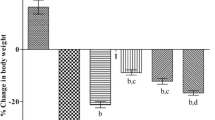Abstract
Theanine, r-glutamylethylamide, is one of the major components of amino acids in Japanese green tea. Effect of theanine on brain amino acids and monoamines, and the striatal release of dopamine (DA) was investigated. Determination of amino acids in the brain after the intragastric administration of theanine showed that theanine was incorporated into brain through blood-brain barrier via leucine-preferring transport system. The concentrations of norepinephrine, 3,4-dihydroxyphenylacetic acid (DOPAC) and 5-hydroxyindole acetic acid (5HIAA) in the brain regions were unaffected by the theanine administration except in striatum. Theanine administration caused significant increases in serotonin and/or DA concentrations in the brain, especially in striatum, hypothalamus and hippocampus. Direct administration of theanine into brain striatum by microinjection caused a significant increase of DA release in a dose-dependent manner. Microdialysis of brain with calcium-free Ringer buffer attenuated the theanine-induced DA release. Pretreatment with the Ringer buffer containing an antagonist of non-NMDA (N-methyl-D-aspartate) glutamate receptor, MK-801, for 1 hr did not change the significant increase of DA release induced by theanine. However, in the case of pretreatment with AP-5, (±)-2-amino-5-phosphonopentanoic acid; antagonist of NMDA glutamate receptor, the theanine-induced DA release from striatum was significantly inhibited. These results suggest that theanine might affect the metabolism and/or the release of some neurotransmitters in the brain, such as DA.
Similar content being viewed by others
REFERENCES
Sakato, Y. 1949. Studies on the chemical constituent of tea. Part III. On a new amide theanine. Nippon Nogeikagaku Kaishi 23:262–267.
Kuhn, D. M., Wolf, W. A., and Lovenberg, W. 1980. Review of the role of the central serotonergic neuronal system in blood pressure regulation. Hypertension 2:243–255.
Bresnahan, M. R., Hatzinikolaw, P., Brunner, H. R., and Gavras, H. 1980. Effect of tyrosine infusion in normotensive and hypertensive rats. Am. J. Physiol. 239:4206.
Lown, B., Temte, J. V., and Reich, P. 1976. Basis for recurring ventricular fibrillation in the absence of coronary heart disease and its management. New Eng. J. Med. 294:623–629.
Sved, A. F., Fernstrom, J. D., and Wurtman, R. J. 1979. Tyrosine administration reduces blood pressure and enhances brain norepinephrine release in spontaneously hypertensive rats. Proc. Natl. Acad. Sci., U.S.A. 76:3511–3514.
Yokogoshi, H., Kato, Y., Sagesaka, Y., Matsuura, T., Kakuda, T., and Takeuchi, N. 1995. Reduction effect of theanine on blood pressure and brain 5-hydroxyindoles in spontaneously hypertensive rats. Biosci. Biotech. Biochem. 59:615–618.
Oldendorf, W. H., and Szabo, J. 1976. Amino acid assignment to one of three blood-brain barrier amino acid carriers. Am. J. Physiol. 230:94–98.
Christensen, H. N. 1979. Developments in amino acid transport, illustrated for the blood-brain barrier. Biochem. Pharmacol. 28:1989–1992.
Sershen, H., and Lajtha, A. 1979. Inhibition pattern by analogs indicates the presence of ten or more transport systems for amino acids in brain cells. J. Neurochem. 32:719–726.
Wade, L. A., and Brady, H. M. 1981. Cysteine and cystine transport at the blood-brain barrier. J. Neurochem. 37:730–734.
Horie, K., Morita, A., and Yokogoshi, H. 1995. Endothelin-1 and endothelin-3 modulate dopaminergic neurons through different mechanisms. Life Sci. 57:735–741.
Yokogoshi, H. 1985. Effect of dietary level of protein or methionine and threonine on the amino acids and catecholamines in brain of rats fed a high tyrosine diet. J. Nutr. Sci. Vitaminol. 31:519–531.
Paxinos, G., and Watson, C. 1986. The rat brain in stereotaxic coordinates, Academic Press, New York.
Duncan, D. B. 1957. Multiple-range tests for correlated and heteroscedastic means. Biometrics 13:164–176.
Pastuszko, A., Yee, D. K., and Wilson, D. F. 1986. Regulation of calcium uptake in synaptosomes from rat brain by D,L-2-amino-5-phosphonovaleric acid. FEBS Lett. 218:189–194.
Yee, D. K., Pastuszko, A., Nelson, D., and Wilso, D. F. 1989. Effects of DL-2-amino-5-phosphonovalerate on metabolism of catecholamines in synaptosomes from rat brain. J. Neurochem. 52:54–60.
Drewes, L. R., and Gilboe, D. D. 1973. Glycolysis and the permeation of glucose and lactate in the isolated, perfused dog brain during anoxia and postanoxic recovery. J. Biol. Chem. 248:2489–2496.
Fernstrom, J. D., and Wurtman, R. J. 1971. Brain serotonin content: physiological dependence on plasma tryptophan levels. Science 173:149–152.
Rubin, R. A., Ordonez, L. A., and Wurtman, R. J. 1974. Physiological dependence of brain methionine and S-adenosylmethionine concentrations on serum amino acid pattern. J. Neurochem. 23:227–231.
Cohen, E. L., and Wurtman, R. J. 1976. Brain acetylcholine: Control by dietary choline. Science 191:561–562.
Gibson, C. J., and Wurtman, R. J. 1978. Physiological control of brain norepinephrine synthesis by brain tyrosine concentration. Life Sci. 22:1399–1406.
Yokogoshi, H., and Wurtman, R. J. 1986. Meal composition and plasma amino acid ratios: Effect of various proteins or carbohydrates, and of various protein concentrations. Metabolism 35:837–842.
Yokogoshi, H., Iwata, T., Ishida, K., and Yoshida, A. 1987. Effect of amino acid supplementation to low protein diet on brain and plasma levels of tryptophan and brain 5-hydroxyindoles in rats. J. Nutr. 117:42–47.
Yokogoshi, H., Hayase, K., and Yoshida, A. 1992. The quality and quantity of dietary protein affect brain protein synthesis in rats. J. Nutr. 122:2210–2217.
Kitaoka, S., Hayashi, H., Yokogoshi, H., and Suzuki, Y. 1996. Transmural potential changes associated with the in vitro absorption of theanine in the guinea pig intestine. Biosci. Biotech. Biochem. 60:1768–1771.
Pardridge, W. M. 1977. Regulation of amino acid availability to the brain. Pages 141–204, in Wurtman, R. J., and Wurtman, J. J. (eds.), Nutrition and the brain, Raven Press, New York.
Shimizu, N., Duan, S., Hori, T., and Oomura, Y. 1990. Glutamate modulates dopamine release in the striatum as measured by brain microdialysis. Brain Res. Bull. 25:99–102.
Mayer, M. L., Westbrook, G. L., and Guthrie, P. B. 1984. Voltage-dependent block by Mg2+ of NMDA responses in spinal cord neurons. Nature 309:261–263.
Nowak, L., Bregestovski, P., Ascher, P., Herbert, A., and Prochiantnz, A. 1982. Magnesium gates glutamate-activated channels in mouse central neurons. Nature 307:462–465.
Author information
Authors and Affiliations
Rights and permissions
About this article
Cite this article
Yokogoshi, H., Kobayashi, M., Mochizuki, M. et al. Effect of Theanine, r-Glutamylethylamide, on Brain Monoamines and Striatal Dopamine Release in Conscious Rats. Neurochem Res 23, 667–673 (1998). https://doi.org/10.1023/A:1022490806093
Issue Date:
DOI: https://doi.org/10.1023/A:1022490806093




